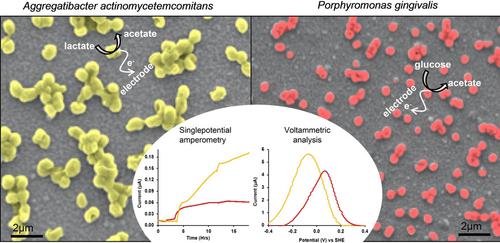当前位置:
X-MOL 学术
›
ChemElectroChem
›
论文详情
Our official English website, www.x-mol.net, welcomes your feedback! (Note: you will need to create a separate account there.)
Electrochemical Characterization of Current‐Producing Human Oral Pathogens by Whole‐Cell Electrochemistry
ChemElectroChem ( IF 4 ) Pub Date : 2020-03-11 , DOI: 10.1002/celc.202000117 Divya Naradasu 1, 2 , Alexis Guionet 1 , Toshinori Okinaga 3 , Tatsuji Nishihara 4 , Akihiro Okamoto 1, 5, 6, 7
ChemElectroChem ( IF 4 ) Pub Date : 2020-03-11 , DOI: 10.1002/celc.202000117 Divya Naradasu 1, 2 , Alexis Guionet 1 , Toshinori Okinaga 3 , Tatsuji Nishihara 4 , Akihiro Okamoto 1, 5, 6, 7
Affiliation

|
Extracellular electron transfer (EET) via cell‐bound redox enzymes and/or redox shuttles is extensively studied in environmental bacteria. Meanwhile, EET capable pathogens have been identified in the human gut. However, other EET‐capable bacterial niches where possible biofilm infections are prominent have scarcely been explored. Herein, we electrochemically characterized human oral biofilm pathogens, Aggregatibacter actinomycetemcomitans and Porphyromonas gingivalis, to examine their EET capability. Both strains showed current production with the electrode poised at +0.4 V vs. a standard hydrogen electrode, which was associated with a decrease in electron‐donor concentration, coupled with the appearance of oxidative peaks in differential pulse (DP) and cyclic voltammograms (CV). Addition of antibiotics that suppress the biosynthesis of membrane or protein showed a significant current decrease, demonstrating that current production reflects the cellular activity in these pathogens. DPV‐ and CV‐based kinetic analyses supported by transmission electron microscopy of the cells stained for transition metals suggest a potential EET mechanism associated with the presence of redox enzymes on the cell membrane. These results could be the basis to reevaluate human oral pathogens from an electroactive point of view. The identified electrochemical activity of the two strains can be an effective test for assessing the impact of antibacterial compounds on the pathogen cellular activity on an electrode.
中文翻译:

通过全细胞电化学对电流产生的人类口腔病原体进行电化学表征
通过结合细胞的氧化还原酶和/或氧化还原穿梭的细胞外电子转移(EET)已在环境细菌中得到了广泛研究。同时,已经在人的肠道中鉴定出了具有EET能力的病原体。但是,几乎没有研究过其他可能具有生物膜感染的,具有EET功能的细菌生态位。在这里,我们通过电化学方法表征了人类口腔生物膜病原体,放线杆菌和牙龈卟啉单胞菌。检查他们的EET能力。两种菌株均显示出电流产生,电极相对于标准氢电极处于+0.4 V电位,这与电子给体浓度的降低有关,并且在微分脉冲(DP)和循环伏安图(CV)中出现了氧化峰)。添加抑制膜或蛋白质生物合成的抗生素显示电流显着降低,表明电流产生反映了这些病原体的细胞活性。透射电子显微镜对过渡金属染色的细胞进行的基于DPV和CV的动力学分析表明,潜在的EET机制与细胞膜上氧化还原酶的存在有关。这些结果可能是从电活性角度重新评估人类口腔病原体的基础。
更新日期:2020-03-11
中文翻译:

通过全细胞电化学对电流产生的人类口腔病原体进行电化学表征
通过结合细胞的氧化还原酶和/或氧化还原穿梭的细胞外电子转移(EET)已在环境细菌中得到了广泛研究。同时,已经在人的肠道中鉴定出了具有EET能力的病原体。但是,几乎没有研究过其他可能具有生物膜感染的,具有EET功能的细菌生态位。在这里,我们通过电化学方法表征了人类口腔生物膜病原体,放线杆菌和牙龈卟啉单胞菌。检查他们的EET能力。两种菌株均显示出电流产生,电极相对于标准氢电极处于+0.4 V电位,这与电子给体浓度的降低有关,并且在微分脉冲(DP)和循环伏安图(CV)中出现了氧化峰)。添加抑制膜或蛋白质生物合成的抗生素显示电流显着降低,表明电流产生反映了这些病原体的细胞活性。透射电子显微镜对过渡金属染色的细胞进行的基于DPV和CV的动力学分析表明,潜在的EET机制与细胞膜上氧化还原酶的存在有关。这些结果可能是从电活性角度重新评估人类口腔病原体的基础。


























 京公网安备 11010802027423号
京公网安备 11010802027423号